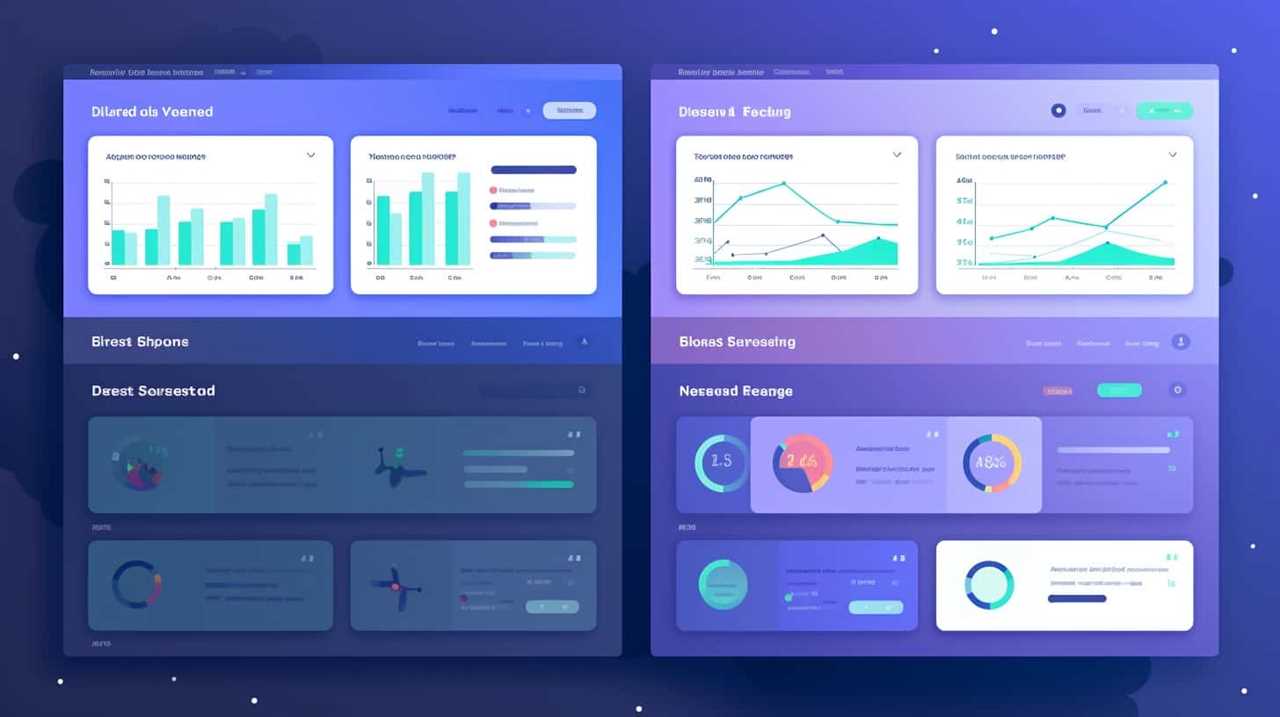Are you ready to advance your SEO expertise to the next level?
We’ve got you covered with nine powerful strategies for enhancing your content and ensuring consistency across your website.
From keyword research to on-page optimization, we’ll show you how to create high-quality content that not only ranks well but also keeps your audience engaged.
With our tips on internal linking, mobile optimization, and social media integration, you’ll be well on your way to dominating the search engine results.

Let’s dive in and master the art of content leverage!
Key Takeaways
- Conduct thorough keyword research and on-page optimization to attract a specific audience actively searching for solutions or information.
- Pay attention to meta tags and URL structure to improve relevancy and visibility in search engine results.
- Create high-quality content and implement an internal linking strategy to enhance SEO and maintain consistency throughout the website.
- Prioritize mobile optimization and social media integration to improve user experience, increase online visibility, and drive more traffic to the website.
Keyword Research
When conducting keyword research, we use various tools and techniques to identify the most relevant and high-performing keywords for our content. One important aspect of our research is competitor analysis. By studying our competitors’ content and keywords, we gain insights into their strategies and discover opportunities to differentiate ourselves. This analysis helps us understand which keywords are performing well for them and allows us to identify gaps in the market that we can leverage.
Another crucial aspect of keyword research is finding long tail keywords. These are specific, niche terms that have lower search volume but higher conversion rates. By targeting long tail keywords, we can attract a more qualified audience that’s actively searching for the specific solutions or information we provide. Long tail keywords also help us compete in a less saturated market, making it easier for our content to rank higher in search engine results.
On-Page Optimization
When it comes to on-page optimization, there are a few key points to keep in mind.

First, pay attention to the importance of meta tags as they provide valuable information to search engines.
Second, make sure to strategically place keywords throughout your content to improve relevancy and visibility.
Lastly, optimize your URL structure by using descriptive and keyword-rich URLs for better search engine rankings.
Meta Tags Importance
We believe that optimizing meta tags is crucial for enhancing on-page optimization in SEO. Meta tags are HTML elements that provide information about a web page to search engines and website visitors. By optimizing these tags, you can improve your website’s visibility and relevance in search engine results pages (SERPs). There are several key meta tags that you should pay attention to:

| Meta Tag | Purpose |
|---|---|
| Title Tag | Displays the title of the webpage in search engine results |
| Meta Description | Provides a brief summary of the webpage’s content |
| Meta Keywords | Specifies relevant keywords for search engines |
| Canonical Tag | Prevents duplicate content issues |
| Robots.txt | Instructs search engine crawlers on how to navigate the site |
To optimize meta tags, you should ensure that each tag is unique, descriptive, and contains relevant keywords. Additionally, make sure that the length of the title and meta description tags fall within the recommended character limits. By optimizing meta tags, you can improve your website’s visibility, click-through rates, and ultimately, its overall SEO performance.
Keyword Placement Techniques
One of the key aspects in on-page optimization for SEO is implementing effective keyword placement techniques. Keyword placement plays a crucial role in optimizing your website’s content and improving its visibility on search engine result pages (SERPs).
When it comes to keyword placement, two important factors to consider are keyword density and the use of long tail keywords.
Keyword density refers to the number of times a keyword appears in your content compared to the total word count. It’s important to strike a balance and avoid keyword stuffing, as search engines may penalize your website for over-optimization. Aim for a natural and organic use of keywords throughout your content.

Long tail keywords, on the other hand, are longer and more specific keyword phrases that target a niche audience. They can help you attract highly targeted traffic and improve your chances of ranking higher on SERPs. Incorporating long tail keywords strategically throughout your content can enhance its relevance and increase its visibility to potential visitors.
URL Structure Best Practices
To ensure optimal on-page optimization for SEO, we’ll now delve into URL Structure Best Practices (On-Page Optimization) and how it contributes to enhancing your website’s search engine visibility and consistency.
URL structure optimization plays a crucial role in improving your website’s search engine rankings and user experience.
When creating URLs for your web pages, it’s important to keep them concise, descriptive, and keyword-rich. For example, instead of using generic URLs like ‘www.example.com/page1’, it’s better to use URLs like ‘www.example.com/product-category/product-name’ that clearly indicate the content of the page.

This not only helps search engines understand the relevance of your page but also makes it easier for users to navigate your website.
High-Quality Content Creation
When creating high-quality content, it’s essential to focus on optimization, consistency, and relevance.
Developing a high-quality content strategy begins with understanding your target audience and their needs.
Conduct thorough keyword research to identify relevant topics and incorporate them strategically throughout your content.

Use content optimization techniques, such as incorporating headings, subheadings, and bullet points, to improve readability and organization.
Keep your content consistent by maintaining a consistent tone and style across all your articles.
Ensure that your content is well-researched, accurate, and provides valuable insights to your readers.
By following these guidelines, you can create high-quality content that not only meets the needs of your audience but also improves your website’s SEO performance.

Now, let’s delve into the next section, which focuses on the importance of an effective internal linking strategy.
Internal Linking Strategy
When it comes to optimizing our website for search engines, internal linking is a crucial strategy that we shouldn’t overlook.
By strategically linking our webpages together, we can improve our site’s SEO performance by signaling to search engines the relevance and importance of our content.
Additionally, internal linking helps boost page authority by distributing link equity across our website, ultimately leading to higher rankings in search results.

Furthermore, implementing an effective internal linking strategy enhances user navigation, making it easier for visitors to find and access relevant information on our site.
Linking for SEO
We implement a strategic internal linking strategy to enhance SEO and improve website consistency. Internal linking plays a crucial role in link building and optimizing anchor text for search engine optimization. Here are three key strategies we employ:
- Contextual Links: We strategically place internal links within the content to provide additional information and guide users to relevant pages on our website.
- Keyword Optimization: We optimize anchor text by using relevant keywords that accurately describe the linked page’s content. This helps search engines understand the context and relevance of the linked page.
- Site Structure: We organize our website’s structure in a logical manner, ensuring that pages are easily accessible and interconnected. This allows search engines to crawl and index our site more effectively, improving overall SEO.
Boosting Page Authority
To boost page authority through internal linking strategy, we leverage various techniques to enhance SEO and improve overall website consistency.
Internal linking refers to the practice of linking one page on your website to another page on the same website. By strategically placing internal links throughout your content, you can improve your page ranking and increase visibility on search engine results pages.

When implementing an internal linking strategy, it’s important to choose anchor text that includes relevant keywords and accurately describes the linked page. Additionally, make sure to prioritize linking to high-quality and authoritative pages within your website.
Enhancing User Navigation
Implementing an internal linking strategy enhances user navigation, allowing us to guide visitors through our website seamlessly. By strategically linking relevant pages within our site, we can improve accessibility and streamline navigation for our users.
Here are three key benefits of implementing an effective internal linking strategy:
- Improved User Experience: Internal links help users easily navigate through our website, making it easier for them to find the information they need. By providing clear pathways and guiding users to related content, we enhance their overall experience.
- Increased Page Views: When we strategically link to other relevant pages within our site, we encourage visitors to explore further, increasing their engagement and the number of pages they view. This can lead to longer session durations and improved SEO performance.
- Enhanced SEO: Internal linking plays a crucial role in SEO by distributing link equity throughout our website. By linking to important pages and using relevant anchor text, we can improve the visibility and ranking of our content in search engine results.
Mobile Optimization
For optimal SEO enhancement and consistency, it is essential to prioritize mobile optimization. With the increasing use of smartphones and tablets, having a responsive design for your website is crucial. Responsive design ensures that your website adapts and functions well on different screen sizes, providing a seamless user experience across all devices. This is important because Google now considers mobile-friendliness as a ranking factor, meaning that websites that are not mobile optimized may be penalized in search results. To help you understand the importance of mobile optimization, here is a table highlighting some key statistics:

| Mobile Usage Statistics |
|---|
| 80% of internet users own a smartphone |
| 57% of all internet traffic comes from mobile devices |
| 53% of mobile users abandon a website if it takes longer than 3 seconds to load |
| Mobile searches for "near me" have increased by over 500% in the past two years |
| 61% of users are unlikely to return to a mobile site they had trouble accessing |
Social Media Integration
Social media integration is a key strategy for enhancing SEO and maintaining consistency. By incorporating social media into your overall digital marketing strategy, you can increase your online visibility, drive more traffic to your website, and improve your search engine rankings.
Here are three ways to maximize the impact of your social media integration:
- Develop a comprehensive social media strategy: Define your goals, target audience, and key messaging. Create a content calendar to ensure regular and consistent posting.
- Optimize your social media profiles: Use relevant keywords and hashtags in your bio, posts, and captions. Link back to your website to drive traffic and improve SEO.
- Foster social media engagement: Encourage users to like, share, and comment on your posts. Respond to comments and messages promptly to build a sense of community and improve your online reputation.
User Experience Enhancement
To improve user experience and further optimize SEO, we focus on website design and functionality.
A well-designed and user-friendly website is crucial for enhancing user engagement and driving website performance. When visitors have a positive experience on your site, they’re more likely to stay longer, explore more pages, and convert into customers.

To achieve this, ensure that your website is visually appealing, easy to navigate, and loads quickly. A clutter-free layout, clear and concise content, and intuitive navigation menus can greatly enhance user experience.
Additionally, optimizing website performance through techniques like image compression, caching, and minimizing HTTP requests can help reduce load times and improve overall user satisfaction.
Regular Content Updates
Updating content regularly is essential for maintaining a strong online presence and improving SEO performance. To ensure content freshness and engage readers, it’s crucial to update blog posts frequently.
Here are three reasons why regular content updates are important:

- Improved SEO: Search engines value fresh content, so updating your blog posts with new information, insights, and keywords can help boost your organic search rankings.
- Increased user engagement: By regularly updating your content, you provide value to your audience and keep them coming back for more. This can lead to higher engagement, longer time spent on your site, and increased conversions.
- Authority building: Regularly updating your content demonstrates your expertise and commitment to staying current in your industry. This builds trust and credibility with your audience, positioning you as a thought leader.
Regular content updates lay a solid foundation for successful backlink building strategies, which we’ll discuss in the next section.
Backlink Building
We actively engage in building backlinks to enhance our SEO performance and ensure consistent online presence. Backlinks are crucial for improving search engine rankings and driving organic traffic to our website.
One effective strategy we employ is link outreach, where we reach out to authoritative websites and request them to link back to our content. This not only helps in increasing our website’s visibility but also establishes our credibility in the industry.
Additionally, we’ve developed a well-defined anchor text strategy. By using relevant keywords as anchor texts in our backlinks, we signal to search engines the relevance and quality of our content. This further boosts our SEO efforts and helps us rank higher in search engine results pages.

Frequently Asked Questions
How Can I Find the Most Effective Keywords for My Content?
We can find the most effective keywords for our content by conducting thorough keyword research. This involves using SEO techniques to identify popular and relevant keywords that will drive traffic to our content.
What Are the Best Practices for Optimizing On-Page Elements Such as Title Tags and Meta Descriptions?
When it comes to optimizing on-page elements like title tags and meta descriptions for SEO, there are several best practices that we can follow. These practices ensure that our content is structured and optimized for maximum visibility and relevance.
How Do I Create High-Quality Content That Engages and Resonates With My Target Audience?
To create high-quality content that engages and resonates with our target audience, we focus on creating personalized experiences. By understanding their needs, pain points, and interests, we tailor our content to provide value and connection.
What Strategies Should I Follow to Effectively Build Internal Links Within My Website?
To effectively build internal links within our website, we follow strategies like choosing the right anchor text and organizing the internal link structure. These techniques optimize our SEO and enhance user experience.

What Are the Key Considerations for Optimizing My Website for Mobile Devices?
When optimizing our website for mobile devices, we must prioritize mobile responsiveness and user experience. Did you know that 57% of internet users say they won’t recommend a business with a poorly designed mobile site?
Conclusion
In conclusion, by implementing these strategies, we can unlock the true potential of our website and enhance our SEO efforts.
Through thorough keyword research and on-page optimization, we can ensure that our content is well-positioned to attract organic traffic.
By focusing on creating high-quality content and regularly updating it, we can keep our audience engaged and improve user experience.

Additionally, by leveraging internal linking, mobile optimization, social media integration, and backlink building, we can further boost our website’s visibility and reach.
Let’s embark on this journey to SEO success together!










